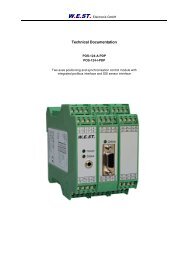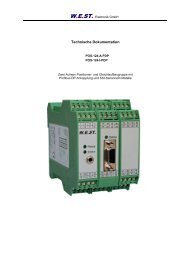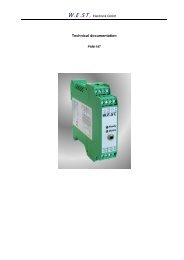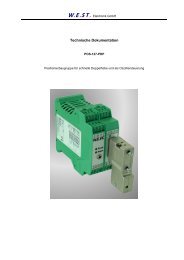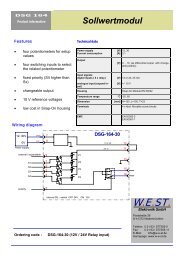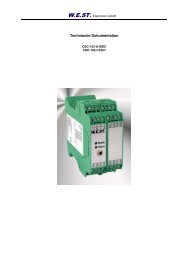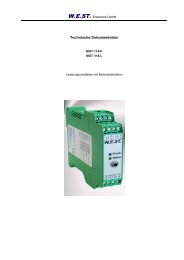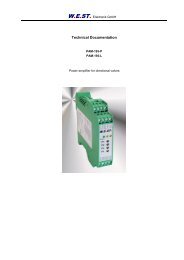Technical documentation
Technical documentation
Technical documentation
You also want an ePaper? Increase the reach of your titles
YUMPU automatically turns print PDFs into web optimized ePapers that Google loves.
W.E.ST. Elektronik GmbH<br />
Analogue inputs<br />
By use of analogue inputs you have to distinguish between symmetrical and asymmetrical inputs.<br />
All analogue inputs must be screened.<br />
The symmetrical input is carried out as a differential input for voltage signals and can be switched over<br />
per software to bipolar or unipolar signals. Especially by use of high-resolution analogue signals an additional<br />
cable twisted in pairs has to be taken.<br />
The asymmetrical inputs are optimized for the two-pole-conductor techniques (voltages or current signals<br />
as usual in the automobile industry). They can be switched over by software between voltage and<br />
current input. A low-impedance GND connection is required for good signal transmission. In this configuration<br />
the return line is the GND of the power supply. Therefore sensors and the control module should be<br />
combined at a common star point (low impedance) with the GND of the power supply. As common potential<br />
the 0V PIN 11 and optionally PIN 12 are used.<br />
All inputs are protected with suppressor diodes and RC-filter against transient overshoots.<br />
Differential input:<br />
Voltage level: bipolar ±10 V (PIN 9 and PIN 10)<br />
unipolar 0… 10 V (PIN 10 against PIN 9)<br />
input resistance: > 91 kΩ<br />
Asymmetrical inputs:<br />
Voltage level: unipolar 0… 10 V (against PIN 11)<br />
input resistance: 25 kΩ<br />
Current level: unipolar 4… 20 mA (against PIN 11)<br />
input resistance: app. 250 Ω<br />
Analogue outputs<br />
The analogue outputs are carried out as symmetrical differential outputs. Because all power amplifiers<br />
have a differential input (especially valves with integrated electronics), an optimal signal transmission<br />
even over greater distances is possible. All analogue outputs have to be wired with screened cables.<br />
Ideally, twisted pair cables are used. For the signal potential or if both outputs are used as two separate<br />
asymmetrical signals (f. e. for plug amplifiers), PIN 12 as GND potential has to be used. All outputs are<br />
protected with suppressor diodes against transient overshoots.<br />
As differential output:<br />
Voltage level: bipolar ±10 V (PIN 15 and PIN 16)<br />
Output current: max. 10 mA<br />
As asymmetrical outputs:<br />
Voltage level: 2 x unipolar 0… 10 V (PIN 15 or PIN 16 against PIN 12)<br />
Output current: max. 10 mA<br />
Seite 12 von 24



